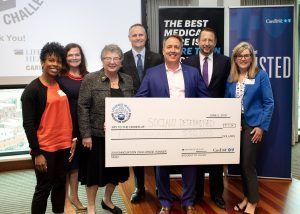
5 Real Estate Development Projects to Watch in Philadelphia
The rapidly growing Philadelphia life sciences sector is hungry for lab and manufacturing space. Real estate developers are meeting that demand with ambitious projects to build, rebuild, and overbuild sites to produce facilities that will retain and attract life sciences companies.
These projects are taking advantage of the favorable infrastructure that made Philly a manufacturing powerhouse throughout the 20th century. The reinvention of the Budd Campus as a life sciences manufacturing destination is a shining example. Plymouth Group, in collaboration with Centerbridge Partners, is transforming the former steel processing giant into 2 million square feet of state-of-the art research and manufacturing space. The Budd Campus continues to grow as Colliers Life Sciences, Inc oversees leasing of the facility.
In partnership with ideas and talent, revitalization projects like the Budd Campus and the Curtis are essential to the health of the Cellicon Valley ecosystem.
Here are five more Philly development projects to watch.
The Navy Yard
Philly’s military shipyard had its origins during the American Revolution. The loss of the storied ship-building facility on the Delaware River in 1995 meant the loss of thousands of jobs as well as a significant chunk of history.
The city of Philadelphia ultimately took ownership of the site, and the area is undergoing a major overhaul, overseen by the Philadelphia Industrial Development Corporation (PIDC). The Navy Yard is now a mixed-use office and industrial location that will eventually expand to become a small town, with residential and retail establishments.
The Navy Yard is also a maturing destination for the life sciences. Several life sciences companies already have footprints within the Navy Yard. For example, Iovance Biotherapeutics, Inc. has opened a facility to develop and manufacture reagents for its T cell-based cancer immunotherapies.
The life sciences, especially cell and gene therapy ventures, continue to grow at the Navy Yard. A 137,000 square foot lab and office space is under construction at 1201 Normandy Place in a speculative project led by Mosaic Development Partners and Ensemble Real Estate Investments. This building will be designed to attract smaller CGT startups. The developers expect to be tenant-ready by 2023.
With ultimate plans for more than 4 million square feet of GMP space for life sciences research and manufacturing, the area promises to be a buzzing hive of industry, reminiscent of its naval history.
Schuylkill Yards
A behemoth skyscraper, the second tallest building in the city, will be the most obvious feature of Schuylkill Yards in the University City area of West Philly when it is completed in 2035.
Near-term plans for Schuylkill Yards call for a mixed-use development that promises to bring additional momentum to the area’s life sciences push. In partnership with Drexel University, Brandywine Realty Trust is developing this area to eventually include more than 6 million square feet of state-of-the-art life sciences R&D facilities.
Next door to the proposed skyscraper, at 3151 Market Street, plans are well underway for the construction of a 14-story life science R&D complex full of flexible and customizable lab and office spaces. Groundbreaking is imminent, with expected delivery during the second quarter of 2024.
Also planned for the Schuylkill Yards area of University City is a collaboration between Spark and Drexel University. This $575 million, 500,000 square foot center for gene therapy innovation at the intersection of 30th and Chestnut Street promises to nurture the collaborative nature of the Philly life sciences scene.
Pennovation Works
The Pennovation Works site has been “an incubator for industry and innovation in the Philadelphia area for over 200 years”. In 2010, the nearby University of Pennsylvania reinvigorated an old paint factory and chemical research facility into the Pennovation Center, a 58,000 square foot incubator for startups originating at UPenn and throughout the region.
The Pennovation Works site also features the new Pennovation Lab, a graduate space appealing to promising early-stage companies that have outgrown incubators.
In light of the growing successes of the CGT initiatives of UPenn and the Gene Therapy Program, an additional $365 million plan is in the works to expand Pennovation Works incubation and growth space specifically for innovations in the life sciences. Most of the new space will be used for research and development, but 65,000 of the 500,000 square feet have been carved out for manufacturing.
This growth project is led by Longfellow Real Estate Partners. Construction of the building, at 34th Street and Grays Ferry Avenue, is slated to begin next year, with an estimated opening in 2025.
2300 Market Street
About three miles away from Pennovation, in the Center City district, sits a new project of the global development firm Breakthrough Properties.
Breakthrough has plans to perform an overbuild of the existing structure at 2300 Market Street. Prior to Breakthrough’s acquisition of the project, the plan was for a mixed-use residential, office, and retail space. The updated plan calls for 200,000 square feet of “best-in-class” life sciences R&D space, with a sustainable footprint that hopes to earn LEED Gold Certification.
The 2300 Market Street project is still early in the planning stages, but once completed, it will be optimally situated with convenient access to UPenn, Drexel, and the other “meds and eds” that have been a driving force in the growth of life sciences in the region.
Lower Schuylkill Biotech Campus
In another early stage project, PIDC is seeking developers and end-users for an ambitious CGT manufacturing facility.
PIDC envisions a 40 acre campus with up to one million square feet of manufacturing space. That space will bring needed manufacturing capacity into an ecosystem teeming with early stage innovations.
The biotech campus is part of the larger planned Lower Schuylkill Innovation District, which includes the Pennovation Works site. This 75 acre project, begun in 2012, was designed to rehabilitate the decaying infrastructure in the area and create thousands of jobs.






